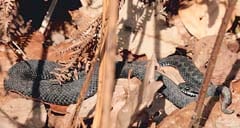AN UNUSUAL melanistic, or black adder has been photographed in the Dean
These dramatic photographs of the near black snake, Britain's only poisonous species come as both males and females come out of hibernation and head towards the spring mating season.
Wildlife enthusiast, Rob Ward, who took these remarkable photographs says melanism is the opposite to being an albino. It results from an increase in dark pigments and is more commonly found in snakes in the colder north, possibly because darker skins absorb heat quicker, allowing black snakes to warm up faster.
The location of the photographs is being kept a closely guarded secret because snakes do provoke panic, even though the last human death from an adder bite was back in 1985. In comparison, there are an average of four deaths a year as a result of wasp stings.
"I have been monitoring and surveying reptiles and amphibians in the Forest of Dean for more than a decade," says Rob, from Cinderford. "And in that time I've come across snakes of all sizes and colours. Yes, colours. But the saddest thing is that some of them are dead. Battered to death because some people develop an urge to kill what they perceive as dangerous creatures."
Of Britain's three native snakes, only two are found in the Dean – the grass snake, often found near water and the adder which likes sunny areas of heath or scrub. Adders live about 15 years and the females, which are larger than the males, give birth to up to 10 live young a year. Harmless olive coloured grass snakes have a yellow collar round their necks and live longer - up to 25 years and lay anything up to 30 eggs. Like the adder, they only breed every other year.
Rob has been surveying for the National Amphibian and Reptile Recording Scheme and working closely with the Forestry Commission to map out reptile sites for protection.
"Snakes may be scary to some, but every living thing on the planet has a purpose. Stand back and admire them, see them for their beauty and magnificence. They need and deserve our help and respect."
Gloucestershire Naturalists' Society reptile recorder, Colin Twissell, said there's no real records of how many adders there are in the Dean, but he confirmed males began emerging from hibernation a couple of weeks ago.
"The males hibernate together in groups. When they warm up they'll begin to slough (shed their skin) and go in search of a receptive female. If they find one they'll twist around together in a sort of fight to see who's strongest. Then they spring apart. It happens quite quickly, but if you happen to see it, it's fantastic."
Most at risk from adder bites are dogs snuffling through the undergrowth and alarming one of the snakes.
"Dogs do pretty much everything by nose," says Rob Ward. "Adders only bite in self defence but bites will probably occur on the face or nose, which is not a good place for a snake bite. Also antivenom isn't always stocked locally.
"Adders will bask around the edges of bracken and gorse and fern because they want the sun for energy. Best advice is to keep your dog on a short lead and away from the verges on hot sunny days."


.jpeg?width=209&height=140&crop=209:145,smart&quality=75)


Comments
This article has no comments yet. Be the first to leave a comment.